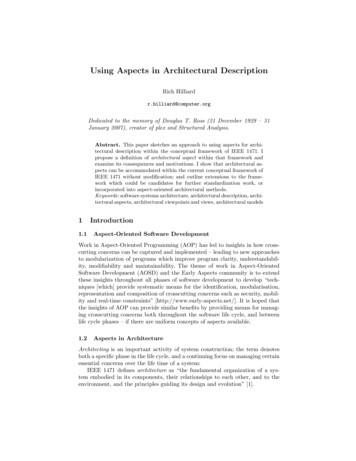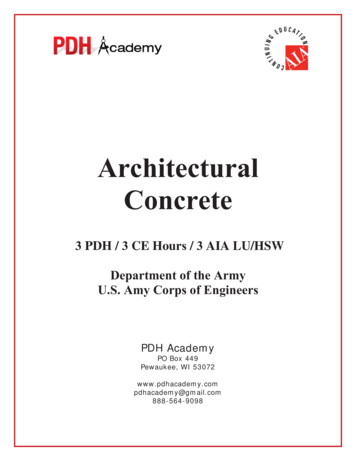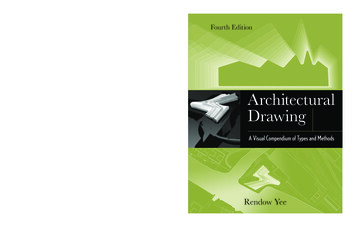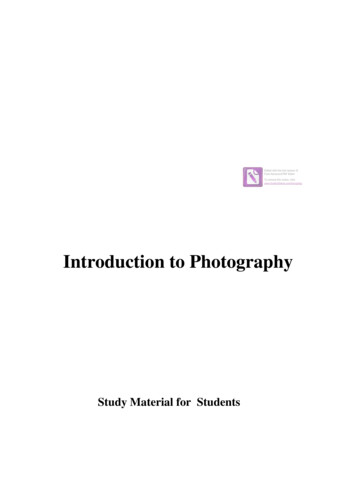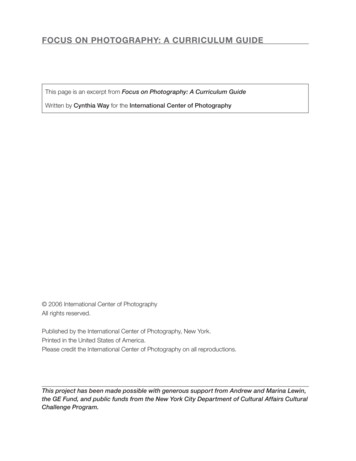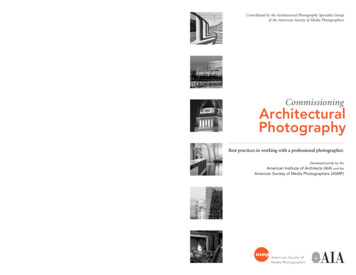
Transcription
Contributed by the Architectural Photography Specialty Groupof the American Society of Media PhotographersAbout AIASince 1857, the AIA has represented the professional interests of America’s architects. As AIAmembers, over 83,500 licensed architects, emerging professionals, and allied partners expresstheir commitment to excellence in design and livability in our nation’s buildings and communities.Members adhere to a code of ethics and professional conduct that assures the client, thepublic, and colleagues of an AIA-member architect’s dedication to the highest standards inprofessional practice.The AIA website, www.aia.org, offers more information.CommissioningAbout ASMPFounded in 1944, the American Society of Media Photographers (ASMP) is the leading tradeassociation for photographers who create images primarily for publication. ASMP promotesphotographers’ rights, educates photographers in better business practices, produces businesspublications for photographers, and helps buyers find professional photographers.ArchitecturalÊPhotographyBest practices in working with a professional photographer.The ASMP website, www.asmp.org, offers more information.Developed jointly by theAmerican Institute of Architects (AIA) and theAmerican Society of Media Photographers (ASMP)The AIA collects and disseminates Best Practices as a service to AIA members without endorsement orrecommendation. Appropriate use of the information provided is the responsibility of the reader. You maydownload this document freely from ASMP at www.asmp.org/architecture or from Chapter 6 of the AIABest Practices archive at www.aia.org/bestpractices. 2008 AIA and ASMP
ContentsSelecting a Professional Photographer. . . . . . . . . . . . . . . . . . . . . . . . . . . . . . . . 2Understanding the Estimate for a Photographic Assignment . . . . . . . . . . . . . . 5on time, on budget and looking better than you expected. Photography requires avisual style that presents your work to its best advantage.Images play a major role in defining how we come to know architecture and interiorspaces. Because photography is pivotal in understanding the built environment, choosinga professional to photograph your project is a most important consideration. Hereare suggestions to make the experience of photographing your project a good one.Controlling the Cost of a Photographic Assignment . . . . . . . . . . . . . . . . . . . . 10Licensing Photographs for Publication . . . . . . . . . . . . . . . . . . . . . . . . . . . . . . 14Preparing for Professional Photography: A Checklist . . . . . . . . . . . . . . . . . . . . 17IDENTIFY YOUR NEEDSWhich aspects of your project might best represent your design? Would you like tohighlight any specific concepts, architectural elements, or other features? Are someareas best avoided? Which areas would illustrate creative problem solving?Next, ask yourself how will you use the photography as an integrated part of yourmarketing plan? Showthe photos to clients via website, portfolio or presentationthe photos for in-house reference/documentation Use the photos for internally produced publications Submit the photos for competitions Send to editors of trade magazines or books Use the photos in trade or consumer advertising UseRiverbend MusicCenter, Cincinnati OH.Designed by MichaelGraves. Photographedby Ron Forth(www.ronforthphoto.com).Selecting aProfessional PhotographerThe answers to these questions will help you and the photographer define theassignment parameters and develop cost estimates.Share costs. Inquire whether other parties in your project (such as the owner,contractors, consultants, product suppliers, financing sources, or even public agencies)might be interested in participating in the assignment and sharing the expenses.If so, all of the participants should likewise identify their needs and priorities.It is important that the participants understand which costs are shared and whichare not. The total price has three components: creative/production fees, expensesand rights licenses. Expenses (e.g., travel; consumables; equipment or prop rentals;and fees paid to assistants, models and stylists) and production fees (the photographer’stime, expertise and judgment) can be shared on any basis the participants choose.Rights licenses, in contrast, are based on the use each participant makes of theimages and are not shared or transferable among the parties.W H E N O N LY E X C E L L E N C E W I L L D OImage quality relates to persuasion. You aren’t merely documenting your work but areactively trying to convince other people that yours is the best of its class. Photography,like any other custom service, is never a “one size fits all” proposition, but a matterof finding the right person for the job.Just as architecture is more than construction materials, photography goes farbeyond the mechanics of focus, exposure, and composition. It requires an aestheticaptitude for creating a unique and compelling presentation of a physical structure.It requires craft: knowing how to choose lenses and aim lights, caring for details ofcleanliness and arrangement, understanding what color adjustments create the mostimpact on a printed page and making sure permissions and releases are secured.It requires professionalism, ensuring that finished images will be delivered reliably,R E S E A R C H T H E C A N D I D AT E SThere are a number of possible strategies for finding the right photographer for thejob. One is to scan architecture magazines for images that impress you and find outwho made them. If the photo credits do not appear next to the pictures, they areusually near the magazine’s table of contents or masthead. If an advertisement doesnot show photo credits, a call to the advertiser or ad agency might produce aname. Ask your professional colleagues for a recommendation.To narrow the field of candidates, visit photographers’ websites, request samplesof their work or schedule meetings for portfolio presentations. Be aware that websitesand portfolios often represent only a limited selection of the photographer’s work.When asking to see portfolios, request images from assignments of similar scopeand building type to the project you have in mind.2 Commissioning Architectural PhotographyCommissioning Architectural Photography 3
Architectural photography is a specialty within the profession, requiring differenttools and skills than, say, weddings or wildlife. Within the specialty are furtherspecializations—interiors,exteriors, landscapes, aerials—that may be important toFIND A PHOTOGRAPHERyour project. One criterionThe American Society of Media Photographersfor evaluating a website or(ASMP) operates a free “Find a Photographer”portfolio is whether the imagesservice at www.FindaPhotographer.org. Onlyindicate that the photographerqualified professionals are in this database,has the skill and experienceand you can search by geographic locationyou want.and photographic specialty. The search resultsThe photographer’s “vision”include full contact information, sampleor stylistic approach is just asphotographs and website links.critical. You want a visual stylethat complements both yourarchitectural design and your marketing goals. Evaluating this factor is often theprimary goal of a portfolio review.A S K F O R E S T I M AT E SOnce you have identified the few photographers who seem to have the experience,skills and vision that match your goals, ask for estimates. You are not looking fora “lowest bidder” but rather a confirmation that each candidate understands thenature of the assignment. This understanding should encompass your budgetaryand marketing goals.Although photography is a competitive industry, it is not a commodity business;expect variations in the initial proposals you receive. The differences may reflect thephotographers’ experience, professional stature, different creative approaches andinterpretations of your needs.An estimate is not set in stone. If it reveals a misunderstanding of your requirements,call the photographer to discuss the matter. The photographer might make suggestionsthat could yield better results or lower costs. For some concrete suggestions, see“Controlling the Cost of a Photography Assignment” on page 10.Don’t underestimate the value of a photographer’s enthusiasm and experience,as he or she can become an important part of your creative team.Try to match your needs with a photographer’s strengths, professionalism andcompatibility with your style. The right photographer for you is one who understandsyour design ideas and can communicate them visually to the wider world.Soldier Field Renovation. Architects: Lohan, Caprile & Goettsch andWood Zapata. Photographed by David Seide(www.DefinedSpace.com).Understanding the Estimatefor a Photographic AssignmentS P E C I F I C AT I O N S F O R T H E E S T I M AT EAs a creative professional, you undoubtedly understand the importance of accuratelydefining the scope of work in order to determine your firm’s design fees. Similarly,to prepare an estimate, a photographer must have a detailed description of theassignment.Before you request an estimate, list the aspects of your project that you think mightbest represent your designs. The list should identify: Assignmentdescription with any specific concepts, architectural elements, ordesign features you’d like to highlight. How the images might be used: documentation, portfolio, editorial features,advertising, design competition submissions, websites and so on. Other parties, such as contractors or consultants on the project, who may want touse the photos. Deliverables needed, such as digital files, prints or transparencies.These are the major factors that a photographer needs to know in order to framean accurate, detailed estimate. Based on all these factors, the photographer submitsa formal estimate for the assignment. A photography estimate includes the assignmentdescription plus three other components: Licensingand rights grantedfees Creative/production ExpensesLet us look at each of these in turn.4 Commissioning Architectural PhotographyCommissioning Architectural Photography 5
THE ASSIGNMENT DESCRIPTIONA description of the project will include its name and location, the number of views,a list of deliverables and a timeframe for completing the assignment, plus anyextraordinary circumstances, such as dawn shots, all-night sessions, views fromcherry pickers, or aerial photos.In some cases, the photographer may propose alternatives to your initial specifications. As a creative professional, he or she may be able to visualize some ideasyou hadn’t considered or to find ways to get the desired results at lower cost.This information may be detailed in the licensing section of the estimate, or itmay be supplied in a separate licensing agreement that grants specific rights tocommissioning clients. If several parties agree to share in the cost of an assignment,the photographer will develop a separate licensing agreement for each individualclient to cover the permissions and rights.PRICINGA photographer’s fee typically has three components: CreativeCOPYRIGHT LAWUnder the Copyright Act of 1976 and the Berne Convention for the Protection ofLiterary and Artistic Works, photographs (like designs and drawings) automaticallyreceive copyright protection immediately upon their creation. Copyright gives thecreator of an image the exclusive legal right to control how the image is used.This control is exercised by granting licenses to specific persons for specificuses. The right to use an image cannot be transferred by anyone without thewritten consent of the copyright holder.Absence of a copyright notice does not mean that an image is free of copyright, and it does not relieve a prospective user from the responsibility ofobtaining permission from the copyright holder. Altering or removing a copyrightnotice can result in liability under the Copyright Act and several other stateand federal statutes. Simply having physical possession of photographs, slides,prints, transparencies, or digital files does not grant the right to use them.Practical implicationsIt’s important that you and your photographer agree on the scope of the licensebefore the contract is signed and photography has begun. Outline your tentativeplans for using the images, even if they are vague at the moment, and negotiatefor optional future rights at the outset. Should your marketing plans changemid-course, be sure to discuss them with your photographer.If you are interested in sharing photographs with third parties who have notbeen involved in the commissioned assignment (e.g., members of the design team,contractors, consultants, product manufacturers, clients, tenants, or magazineeditors), they must understand that any use of the photos requires a writtenlicense agreement from the photographer and payment for usage. If you’vereceived photographs without written permission for their use, do not use themuntil you have secured licensing rights directly from the photographer.LICENSING AND RIGHTS GRANTEDA photograph, like an architectural design, is considered intellectual property. Thephotographer owns the copyright to the images he or she creates and has theexclusive right to license their use. Licensing agreements are specific with regardto use and should answer three basic questions: Whowill use the images?and where will the images appear? How long will the images be used? How6 Commissioning Architectural Photographyor production feefee Expenses LicenseUnless there is reason to separate them, some photographers will quote anumbrella “creative fee” that includes both the production fee and the license fee.However, when several parties have agreed to share costs, they usually need tolicense different rights, and the production and license fees will generally be statedseparately.Creative or production fee. This component reflects the time and skill it takes tocomplete the assignment. Variables include the total number of views, schedulingand deadlines, site logistics and artistic considerations such as unique vantage pointsor special times of day. Intangible variables include the experience, creativity andvision that the photographer brings to the assignment.In addition to the time spent behind the camera, a photographer’s preproductionand postproduction time is included in the production fee. Preproduction tasks mayinclude client meetings, advance site visits, meetings with the facility’s managementto organize access, conversations with building engineers to arrange technical coordination with lighting, landscape maintenance and other site-specific preparation.Postproduction tasks commonly include image editing and selection (which mayinvolve more client meetings), digital processing (color correction, minor retouching, compositing), and preparing master files for final delivery. It is not unusual forthe postproduction work to consume as much time as the photography.License fee. This component (sometimes referred to as the usage fee) reflects thevalue of the authorized uses for the images. The value is determined by a numberof considerations, including how widely and for how long the images will be viewed,reproduced and distributed. Typically, the more extensive the use, the higher thefee will be.Licenses use specific language to describe the rights being conferred. A glossary oflicensing terms used in the photography and publishing industries has been compiledby PLUS (Picture Licensing Universal System); visit www.useplus.com to browse thedefinitions.To obtain the best value, negotiate a license for the entire group of imagesbased on your current and planned needs. There’s no point in paying for a rightthat you will never use. However, it is smart business to negotiate a commitmentregarding the cost of additional rights that you might need in the future.Expenses. If the job will require travel, specialized equipment, prop rentals, specificinsurances, or fees for location access, these will all be indicated on the estimate.Commissioning Architectural Photography 7
Likewise, the anticipated cost of hiring photo assistants, stylists and models will bepart of the total. There may be some contingent costs, such as for weather delays.Expenses for digital photography may include charges for image capture, digitalprocessing, master file prep and postproduction tasks such as color manipulationand digital retouching, archiving and file delivery. For film photography, expensestypically include material charges for film, processing and supplies.DIGITAL PROCESSING COSTSPeople outside the graphic arts are often surprised to learn that equipment andprocessing costs for digital photography are actually greater than for traditionalfilm photography.Digital technology saves time and money “downstream” when the imagesare used in various printing and publishing applications, but it requires thephotographer to spend considerable postproduction time to get the best results.In effect, the photographer has taken over the work of the film lab, print lab andprepress house. The specialized tools for capturing and processing high-end imagefiles are expensive and (as with most computer systems) are quickly obsolete.Both digital and film techniques can yield fine images. In specific circumstances,the photographer may prefer one or the other for technical reasons.Delivery considerationsIf the image is to be delivered digitally, it may have to be processed in severaldifferent ways. Each destination has its own particular requirements. UPDIG, acoalition of imaging organizations, describes current best practices for a widerange of applications on its website, www.updig.org.It may seem as though there are endless variations for delivering high-qualityimages, but your photographer will be able to simplify the options as youdecide on your needs.THE FINE PRINTThe estimate will have a space for your signature. By signing and returning a copyto the photographer, you indicate your acceptance of the assignment description,license and total price. At that point, the estimate becomes a contract.Attached or on the back of the estimate will be a set of Terms and Conditions. Aswith any contract, one purpose is to agree on each party’s responsibilities if problemsarise and how any disputes will be resolved. Another purpose is to state the industrynorms. For photography, these include copyright, photo-credit requirements andwhat alterations (such as compositing) you can make to the images.S U M M A RYThe photographer’s estimate is more than a financial document; it can serve yourcreative and promotional planning needs as well. It is a tool that can help you meetyour business objectives, your documentation needs and your marketing goals.Los Angeles City Hall. Designed byJohn Parkinson. Photographed by JohnMacLean (www.johnmaclean.com). Aproperly exposed and slightly butbelievably enlarged moon replaces theactual moon.A WORKING DOCUMENTJust as a breakout of fees and responsibilities between architect and client allowsthe client to make adjustments to the project, so breaking out the components ofthe fee structure allows architects to work with the photographer in changing theproposed scope of work with a minimum of disruptions.For example, suppose you initially asked for an estimate based on creatingimages to be used for brochures, office displays, exhibitions and a website. Afteryou see the images, you decide to also submit them to a magazine in conjunctionwith an article on your project. This constitutes an extra use, for which there willbe an additional license fee (and perhaps additional expenses to deliver optimizedimages), but the production fee would not be materially changed.Likewise, you may find that the estimate for the work as originally proposed ishigher than you had budgeted. Find out where there is room to reduce costs withoutsacrificing the objective of visually “telling the story” of the project through theessential views. In addition, the photographer may have suggestions for capturingmore successful views without significantly increasing the costs. We offer somepractical recommendations on page 10.8 Commissioning Architectural PhotographyCommissioning Architectural Photography 9
Controlling the Cost ofa Photographic AssignmentPHOTOGRAPHY TO FIT YOUR BUDGETProfessional photography is of great value in advertising, marketing, magazine articles,competition submissions and office décor. Good imagery is a powerful tool forconveying the quality of your work.Like architectural design and development, professional photography is acustom service that can be molded to meet your business goals and stay withinyour financial constraints. If your needs seem to outweigh your means, don’tbe discouraged. Following are a few ideas to relieve the pressure on yourbudget.SHARE THE COST WITH OTHERSYou aren’t the only one who might benefit from photographs of a project.The owner, interior designers, landscape architects, contractors, consultants,product manufacturers, tenants and others probably have similar pride in thebuilding and a similar need to market themselves. With some forethought,all may be served by a single photography assignment where the costs can bedistributed equitably, to everyone’s advantage. Photographers who specialize inarchitectural work are quite familiar with such arrangements. If this is your plan,it is essential to let the photographer know about it before the initial estimateis prepared.The production fees (the photographer’s professional time) and expenses(e.g., travel, consumables, props, rental equipment, assistants, models and stylists)are generally not affected by the number of parties unless their separate interestsrequire different views or special setups. A sharing arrangement means these costelements may be lower for each participant.Each party will be charged a separate rights-license fee, which is based on the usehe or she will make of the images. In addition, each participant will pay separatelyfor any special deliverables, such as large-format prints, web galleries, or imagefiles formatted and sized in different ways.CONTRACTUAL FORMALITIESAfter reviewing the assignment parameters, the photographer will provide a writtenestimate that states the terms of the cost-sharing agreement and names the primarycommissioning client and other participating parties.Alternatively, the photographer may draw up separate estimates for each of theparties. This relieves the commissioning client of any responsibility for collectingpayment from the other participants. It also clarifies the cost-sharing details whendifferent parties need different views. For instance, it’s unlikely that the interiordesigner will make much use of the exterior photography, while the architectprobably has limited use for photos of the furniture in the lobby. Nevertheless,each of the parties will get the benefit of dividing the costs that are incurred incommon.10 Commissioning Architectural PhotographyLICENSING AND RIGHTS GRANTEDWhile all the participating parties will be sharing the expenses and the productionfee, each party will pay separately for the uses that he or she will make of theimages. The building owner may need only brochures for prospective tenants, forwhich an advertising brochure license would be needed. The designer might requirewebsite use and glossy prints for a portfolio. The architect might be interested inweb rights, large prints for the office lobby and permission to submit images forcompetitions. Whether the assignment paperwork is framed in terms of separateestimates or a single estimate with primary and additional clients, each party isasked to sign a license agreement.A vast array of uses and rights can come into play for any particular situation.Some common standards exist. PLUS (Picture Licensing Universal System) hascompiled a glossary of licensing terms used in the photography and publishingindustries. Visit www.useplus.com to browse the definitions.A REAL-WORLD SCENARIOSuppose that an owner, a contractor and an architect discuss a cost-sharing proposalfor photography. Two of them agree, but the contractor decides not to participate.A few weeks later, however, he needs to print capability brochures and asks to useimages from the shared photography session. Because he forfeited the option tolicense the images at the pre-negotiated license fee and terms, he is now in thesame position as any outside party requesting use.Photographers are usually willing to license images to third parties but typicallycharge these parties at least as much as the original group for several reasons, includingdifferent delivery requirements, deadlines and license terms. The photographer and thelatecomer will have to negotiate new agreements from the ground up. From the photographer’s point of view, this is an inefficient way to do business. Multiparty licensing iscost-effective because it allows streamlined planning and preparation for photography.In addition, the latecomercan choose from existingimages—while the originalKEY POINTS TOgroup could anticipate only theMULTIPLE-PARTY LICENSINGoutcome of the assignment All participating parties must sign anthey had commissioned. Thereagreement before photography begins.is also the factor of simple Each participant is charged a licensing feefairness: If non-participantscommensurate with his or her specificcould get photography atusage needs.the same cost as participants, Each participant is responsible for ordering andthe benefit of cost-sharingpaying for his or her individual deliverables.arrangements would benegated.Clear communication among all participants is of prime importance, whether thephotographer contracts only with the commissioning party (acting as liaison andcollecting the other parties’ respective shares of the fees) or contracts with each partyseparately. The benefit can quickly be lost if the parties don’t share an understandingabout goals, timelines and licensing rights.Commissioning Architectural Photography 11
A practical wait-and-see approach has its place in obtaining photography, as inany business decision. Sometimes the wise course is to license after the fact; othertimes, it is best to commission a separate assignment. If your requirements arecongruent with the other parties’ needs, there is no benefit in standing aside from amultiparty agreement. Rather, there can be considerable advantage to joining withother parties, not only to minimize cost but also to participate in the job planningand thereby ensure that the resulting images are useful for your business purposes.P L A N A H E A D , A L L O W L E E WAYSchedule photography well in advance and plan for some variability in the timing.Creating photography on a rush basis adds to the expense, while a relaxed schedulemeans that your photographer can work through any last-minute glitches withoutincurring extra expenses.The weather, too, can be a factor. A tight schedule means that foul weather andother uncontrollable variables may become problems. In contrast, an extendedschedule may provide the opportunity to highlight your design with dusk or nightillumination, different people, moving vehicles and even a variety of changingseasonal elements.Another aspect of planning for photography is ensuring the site is prepared beforethe assignment begins. Are the windows clean? Is all the construction equipmentout of sight? Is electric power on? In a pinch, problems can sometimes be retouchedaway, but this adds to the postproduction time and can mean compromises inimage quality. It’s usually easier and less expensive to prevent the problems whileon site.S H O P L O C A L LYIn addition to minimizing the travel expenses, engaging a local photographer willoften allow the most flexibility in scheduling the work. It can also simplify gettingback on schedule after a weather delay.The American Society of Media Photographers operates a free “Find a Photographer”service at www.FindaPhotographer.org that lists several hundred specialists inarchitectural photography. Only qualified professionals are in this database, andyou can search by geographic location and by specialty. The search results includefull contact information, sample photographs and website links.building’s specs can make a big difference to the cost of construction, so smalladjustments to a photographic assignment can drastically alter the cost of images.Your photographer can adviseyou about the options andCONCLUSIONtrade-offs that are available,The decisions you make while planning for thegiving you the freedom tophotography will affect its cost far more thanbalance the costs andany later steps you might take. Here are a fewbenefits to your advantage.options that will help minimize the outlays:The quality of the photography you use to represent Share the costs of the photography assignyour designs is a reflectionment among several stakeholders in the job.of your firm’s values and Prioritize the views you’d like and phase theaffects how the marketwork over a period of time to highlight yourplace perceives your business.design with changing seasonal elements.There will always be someone Hire locally. Visit ASMP’s freewilling to photograph yourwww.FindaPhotographer.org to identifyproject at a lower price. Aqualified photographers near the“bargain” can easily turn intoproject location.an expensive problem when Schedule flexibly to avoid rush work, overthe resulting images dotime costs and to allow for weather delays.not meet expectations andhave to be re-photographed.Commissioning a professional architectural photographer is an investment that canprevent frustration while saving time and money. Most importantly, the photographsyou receive will be a valuable resource for your marketing as well as a source ofinspiration and legitimate pride.USE FEWER VIEWSIt goes without saying that the number of views is a major factor in
portfolio is whether the images indicate that the photographer has the skill and experience you want. The photographer’s “vision” or stylistic approach is just as critical. You want a visual style that complements both your architectural design and your marketing goals. Evaluating this factor is often
